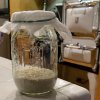- Joined
- May 21, 2019
- Messages
- 248
- Reaction score
- 125
Okay. I’m planning on trying to make sourdough bread. However, after running through books and videos, I’m a tad confused. I want to make sure I understand a few things before I even start to make the starter....so, lets start with that:
(1) Amount of starter: So, one book by a baker is talking 6 QUART container for the starter and the amounts sound way large. This book says that I should toss out half the starter each day and add fresh water/four to make it into one mother of a starter
Book 2 says: “so long as the ratio of water to flour is right, you can use tiny amounts” and don’t bother tossing out any, just add in more fresh water/flour it also says that there shouldn’t be a lot of room between the starter and the lid (we’ll get to that lid)....if it’s a small amount should the container be small to achieve this?
it also says that there shouldn’t be a lot of room between the starter and the lid (we’ll get to that lid)....if it’s a small amount should the container be small to achieve this?
???? I are confused. I’d rather go with small amounts and not toss out half. Is there a logic to tossing out half rather than just adding fresh? And a logic to adding so much that a 6 quart container sound reasonable? And how do I have little air between starter and “lid” if I’m adding more to the container each day....?
(2) About that lid: What do you put on top of the starter’s container? Lid holds in the gas, so not so good, but will plastic suffice? What’s a “poly bag”?
(3) Feeding the starter: Baker book says, after you’ve created the starter (and it’s ready to make bread) keep on “feeding it” like almost daily. Other book says “No need. Once you’ve created it, you’ll need to feed it before you want to make bread (wake it up), but so long as it’s in the refrigerator (dormant in the cold) you don’t need to feed it all that often.”
(4) Last Question: Levain...is this the starter or the starter mixed with water and flour which ferments for 5 hours before being added to the water and flour that will become the dough?
I think that should do for a start
(1) Amount of starter: So, one book by a baker is talking 6 QUART container for the starter and the amounts sound way large. This book says that I should toss out half the starter each day and add fresh water/four to make it into one mother of a starter
Book 2 says: “so long as the ratio of water to flour is right, you can use tiny amounts” and don’t bother tossing out any, just add in more fresh water/flour
???? I are confused. I’d rather go with small amounts and not toss out half. Is there a logic to tossing out half rather than just adding fresh? And a logic to adding so much that a 6 quart container sound reasonable? And how do I have little air between starter and “lid” if I’m adding more to the container each day....?
(2) About that lid: What do you put on top of the starter’s container? Lid holds in the gas, so not so good, but will plastic suffice? What’s a “poly bag”?
(3) Feeding the starter: Baker book says, after you’ve created the starter (and it’s ready to make bread) keep on “feeding it” like almost daily. Other book says “No need. Once you’ve created it, you’ll need to feed it before you want to make bread (wake it up), but so long as it’s in the refrigerator (dormant in the cold) you don’t need to feed it all that often.”
(4) Last Question: Levain...is this the starter or the starter mixed with water and flour which ferments for 5 hours before being added to the water and flour that will become the dough?
I think that should do for a start

